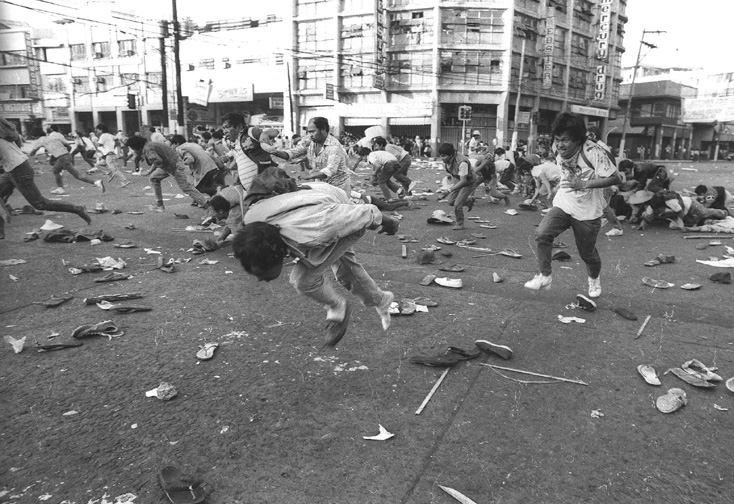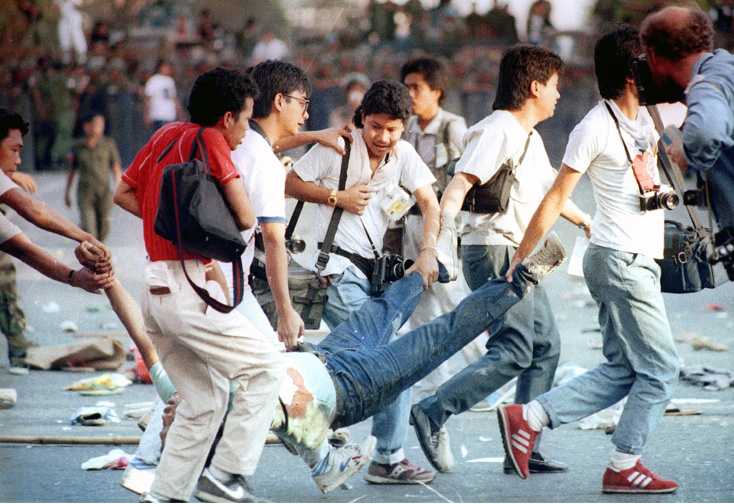By Joseph Holandes Ubalde, InterAksyon
MANILA- Twenty-five years ago, on a narrow bridge near Malacanang, some 10,000 farmers marched to ask then President Corazon Aquino to make good on her promise to implement a genuine agrarian reform program.
Mendiola Bridge was the center of many a protest in the country since the time of Mrs. Aquino's predecessor, the late dictator Ferdinand Marcos. Its proximity to the Palace assured demonstrators that their calls might be better heard. But on January 22, 1987, it was the sound of bullets firing in and screams from the farmers that echoed in the streets outside the presidential palace.
Within a few minutes, 13 farmers lay dead. At least 39 others sustained gunshot wounds, while 20 suffered minor injuries. The media called it “Black Thursday” but it went down in history as “The Mendiola Massacre.”
The tragic event started peacefully in Quezon City. Members of the Kilusang Magbubukid ng Pilipinas (KMP) trooped to the office of the Ministry of Agrarian Reform (now Department of Agrarian Reform) on January 14, to ask for three things: 1) free land to the farmers, 2) zero retention of lands by the landlords and 3) a stop to the amortization of land payments.
Then-KMP chair Jaime Tadeo arrived on January 19 and met with Minister Heherson Alvarez. Tadeo was disappointed that Alvarez was only available for a dialogue the next day. As the picket lines grew, the farmers became more agitated and began to barricade the office on January 20.The following day, tensions mounted when Alvarez told Tadeo to just wait for the ratification of the 1987 Constitution and allow the government of President Aquino to implement the Comprehensive Agrarian Reform Law. But Tadeo refused to wait and urged his fellow peasants to march to Mendiola on January 22 to trumpet their demands to the President.
A passionate Tadeo was quoted in reports as saying: “inalis namin ang barikada bilang kahilingan ng ating Presidente, pero kinakailangan alisin din niya ang barikada sa Mendiola sapagkat bubutasin din namin iyon at dadanak ang dugo. ”
The farmers marched around the Quezon City Circle at around 10 am and were met by other groups like the Bagong Alyansang Makabayan, Kilusang Mayo Uno, League of Filipino Students and Kongreso ng Pagkakaisa ng Maralitang Lungsod. Their collective number reportedly reached between 10,000 an 15,000. At around 4:30 they reached C.M. Recto where some of the rallyists broke through the police lines to Mendiola.In Malacanang, the first line of defense were elements of the Western Police District; the second line were from the integrated national police, and the third were Marine Civil Disturbance Control Battalion. Chaos ensued following an explosion and the throwing of pillboxes, stones and bottles. Then, gunshots were heard. The government’s dispersal team managed to force a retreat among the ralliers until C.M. Recto.
Aquino, dismayed by what happened, formed the Citizens’ Mendiola Massacre to investigate the events and identify who should be held accountable.The victims’ survivors asked for P6 million in damages but the Manila regional trial court dismissed the case in 1988. The Supreme Court agreed with the lower court in 1993.
Twenty five years after the gruesome shootings, Mendiola street including the bridge has become off-limits to protesters. Anti-riot police and the military have employed the use of huge container vans to block ralliers from coming near the Palace. Last year, the Supreme Court finally ruled in favor of the Hacienda Luisita farmers and asked the owners to distribute the land to its tenants for free.
This seems to be a fitting legacy of the Mendiola Massacre, but for the Supreme Court, justice must still be brought to the 13 casualties of the January 22 protest.
In the words of the Supreme Court: "For most Filipinos now, the Mendiola massacre may just as well be a chapter in our history books. For those however, who have become widows and orphans, certainly they would not settle for just that. They seek retribution for the lives taken that will never be brought back to life again.”

Results 1 to 10 of 69
-
01-23-2012, 03:05 PM #1
 Mendiola Massacre: 25 Years, 15 Deaths, 0 Convictions
Mendiola Massacre: 25 Years, 15 Deaths, 0 Convictions
Last edited by gareb; 01-23-2012 at 03:16 PM.
“What we call chaos is just patterns we haven't recognized. What we call random is just patterns we cant decipher. What we can't understand we call nonsense. What we can't read we call gibberish.” - Chuck Palahniuk
-
01-23-2012, 03:15 PM #2
 Re: Mendiola Massacre: 25 Years, 15 Deaths, 0 Convictions
Re: Mendiola Massacre: 25 Years, 15 Deaths, 0 Convictions
Mendiola Massacre: Survivor recounts horror 25 years later
CARMELA LAPEÑA and VERONICA PULUMBARIT, GMA News January 19, 2012 2:00pm
Shot between the eyes and declared brain dead, Bong Manlulu was not expected to come out alive from the Mendiola Massacre on January 22, 1987.
Then only 18 years old, Bong was among some 20,000 marchers who headed to Malacañang Palace, demanding distribution of lands to farmers and zero retention of estates by landowners. They were stopped at Mendiola Bridge.
The one sitting in Malacañang at that time was the late President Corazon "Cory" Aquino, mother of the incumbent President Benigno Simeon "Noynoy" Aquino III.
Bong, now 43, said he was a student of the University of the Philippines in Los Baños (UPLB) when he joined Southern Luzon activists in going to Mendiola, where rallyists from different parts of the country were calling for "genuine land reform."
Upon reaching Mendiola Bridge, however, the shocking happened. Government forces suddenly fired without warning at the marchers. Panic ensued and the marchers fled, scrambling to escape the bridge, a bloody sea of tattered streamers.
(click on above link for full story)

As more shots are fired, protesters at Mendiola flee for their lives. Ramon Acasio

Photographers Alex Nueva España, Derek Soriano, Ramon Acasio, and Claro Cortes III carry a wounded protester to a nearby press vehicle that will take victim to a hospital.Luis LiwanagLast edited by gareb; 01-23-2012 at 03:20 PM.
“What we call chaos is just patterns we haven't recognized. What we call random is just patterns we cant decipher. What we can't understand we call nonsense. What we can't read we call gibberish.” - Chuck Palahniuk
-
01-23-2012, 09:21 PM #3
 Re: Mendiola Massacre: 25 Years, 15 Deaths, 0 Convictions
“What we call chaos is just patterns we haven't recognized. What we call random is just patterns we cant decipher. What we can't understand we call nonsense. What we can't read we call gibberish.” - Chuck Palahniuk
Re: Mendiola Massacre: 25 Years, 15 Deaths, 0 Convictions
“What we call chaos is just patterns we haven't recognized. What we call random is just patterns we cant decipher. What we can't understand we call nonsense. What we can't read we call gibberish.” - Chuck Palahniuk
-
01-23-2012, 10:53 PM #4Senior Member

- Join Date
- Oct 2011
- Gender

- Posts
- 868
-
01-23-2012, 11:05 PM #5
 Re: Mendiola Massacre: 25 Years, 15 Deaths, 0 Convictions
“What we call chaos is just patterns we haven't recognized. What we call random is just patterns we cant decipher. What we can't understand we call nonsense. What we can't read we call gibberish.” - Chuck Palahniuk
Re: Mendiola Massacre: 25 Years, 15 Deaths, 0 Convictions
“What we call chaos is just patterns we haven't recognized. What we call random is just patterns we cant decipher. What we can't understand we call nonsense. What we can't read we call gibberish.” - Chuck Palahniuk
-
01-23-2012, 11:19 PM #6Senior Member

- Join Date
- Oct 2011
- Gender

- Posts
- 868
-
01-23-2012, 11:45 PM #7C.I.A.

- Join Date
- Nov 2005
- Gender

- Posts
- 2,355
 Re: Mendiola Massacre: 25 Years, 15 Deaths, 0 Convictions
Re: Mendiola Massacre: 25 Years, 15 Deaths, 0 Convictions
Mendiola Massacre: 25 Years, 15 Deaths, 0 Convictions and 2 Aquino become president,
and yet PNoy wants to get thier hacienda back by bullying the Supreme Court.
-
01-24-2012, 02:22 AM #8
 Re: Mendiola Massacre: 25 Years, 15 Deaths, 0 Convictions
Re: Mendiola Massacre: 25 Years, 15 Deaths, 0 Convictions
Everyone who were accused and/or involved will be long dead before anyone will be convicted.
-
01-24-2012, 03:24 AM #9
 Re: Mendiola Massacre: 25 Years, 15 Deaths, 0 Convictions
Re: Mendiola Massacre: 25 Years, 15 Deaths, 0 Convictions
Hypocrisy jud ang nahitabo sa Mendiola. Ironic also, because an administration that was put into power through a demonstration and active protest could allow this to happen to demonstrators in active protest.
There was hardly any investigation done in the aftermath, hardly any investigation on the roles of Alfredo Lim, and Ramon Montano among those in command. There was no command responsibility.Last edited by æRLO; 01-24-2012 at 03:31 AM.
-
01-24-2012, 06:45 AM #10
 Re: Mendiola Massacre: 25 Years, 15 Deaths, 0 Convictions
Re: Mendiola Massacre: 25 Years, 15 Deaths, 0 Convictions
Is this something that the son learned from the dear mother?
Advertisement
Similar Threads |
|






 Reply With Quote
Reply With Quote


